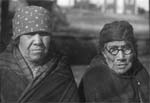|
|
Having listened to the stories told by Lawrence, Bingo and Richard, Cliff SiJohn now invites you to reflect on the seriousness of the oral traditions and on the "First Peoples" - "the messengers." Part 1 (originally developed as part of the 1993 Me-Y-Mi-Ym Project; recorded and edited by Dan Kane; project director Rodney Frey)
|
After listening to the stories and traveling with the Coyote and Chipmunk, you will have begun to appreciate why the oral traditions are so important for the Schitsu’umsh. In re-telling the stories of Coyote, both the young and old of the Tribe learn and remember what it means to smile and laugh, and perhaps also what it means to cry and feel sorrow. The act of sharing the stories offers its listeners a sense of suspense and anticipation, of tragedy and despair, of hope and optimism, and of comic delight and humor. In the laughter that so characteristically comes from the storytelling, listeners are allowed to "lighten the load" in what can be challenging circumstances and to "explore the heavy issues." Humor is also the most difficult element to translate into the English language and sensibilities. The stories thus entertain, providing an emotional outlet and focus, and contributing to the community’s ethos.
|
|
Cliff SiJohn continues reflecting on the importance of the oral traditions as expressed in the stories of Four Smokes and of Coyote and the Rock. Cliff also considers the role of "Water," a gift from the First Peoples. Part 2 |
In re-telling the stories, young and old learn and remember the important teachings established by the First Peoples, the mi'yep. You can learn how you should behave toward others, be they one’s family or one’s neighbors, or be they the animals and plants, mountains and lakes. The stories can educate, becoming the source of one’s identity and heritage, and of what one dreams to become.
The stories anchor a people to their particular creation and to a particular landscape, reaffirmed as one walks the shoreline of Lake Coeur d’Alene or to the top of Grassy Mountain. The oral traditions provide the practical knowledge of the skills necessary for survival, as well as the ethical teachings needed for the "good life." It is Salmon who instructs in the proper use of fishing scaffolds, dip nets, and three-pronged spears. The cunning and deceptive Coyote demonstrates how to face and overcome an enemy, while how not to face a family member. The values of sharing and caring for others are well demonstrated by Four Smokes and Crane.
|
|
Cliff SiJohn continues reflecting upon the importance of the oral traditions as expressed in the stories of Coyote and the White Man, and Coyote and the Green Field. Part 3 |
The act of re-telling the oral traditions is akin to canoeing the waterways of the Plateau. When the story comes to its conclusion for an evening, the storyteller might say, "its time to tie up the story." Upon resuming the storytelling the next evening, the storyteller would say, "now let’s untie the story." And when the storyteller gets off course, on some tangent, a listener might respond by saying, "get on course or you might float away." In the act of speaking the story to life, the listeners travel the unfolding rivers of the story’s landscape, running with the Coyote and witnessing the creation of the world as if for the first time. The canoe is certainly kept on course under the guidance of the storyteller, but it also takes the paddling of the canoe’s participants to bring the story to life.
 | | The Grandmothers, ca. 1937 |
When the story is tied up for an evening or a season, the landscape just revealed and traveled is brought to bear as the story’s listeners now walk beside and along the shores of Lake Coeur d’Alene. It becomes a landscape revitalized and re-embedded with the mi'yep and the teachings of Coyote and Chief Child of the Yellow Root. The landscape that occurred in the mythic past is continued and perpetuated into the present. Any distinctions between the travels occurring within the story during the act of storytelling and the travels occurring after the story are tied up, having become blurred and indistinguishable, as the travelers are well integrated in this perennial landscape. The Animal Peoples are always close at hand, for it is their stories, assisted by canoe travelers, that make the world.
The stories thus become the basis for "mapping" the landscape of the Schitsu'umsh, not only guiding one along but importantly "creating" the best trails leading to the best berry patches and fishing spots. See the discussion on the oral traditions as an important and unique way of "mapping" the world.
While the lessons of history are never to be forgotten, to define what it means to be Schitsu'umsh only in terms of the whiteman’s history is to render the Schitsu'umsh into suyepmsh. It is certainly essential that the history of Jesuit priests, treaty commissioners, and army colonels be remembered with clarity. The legacy of that history continues to reverberate in lives of the Schitsu’umsh today. The priests are still "beloved fathers," the ancestors who died in battle to protect their families and a way of life are still honored, and the treaties help assure the legal claim to a lake, as well as the sovereignty of an entire nation. But what is uniquely Schitsu’umsh was established by Coyote, Chief Child of the Yellow Root, Chipmunk, and all the other First Peoples, and not by the suyepmsh. It is in remembering and in retelling of the world as defined by the First Peoples, and of speaking with "heart knowledge" that there will continue to be Schitsu’umsh.
For additional discussion of the implications and role of the stories, go to Heart Knowledge: Listening to the Ancestors.
© Coeur d'Alene Tribe 2002
< previous |
next >
|











